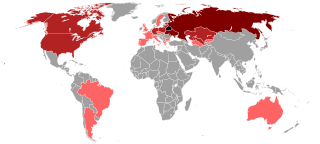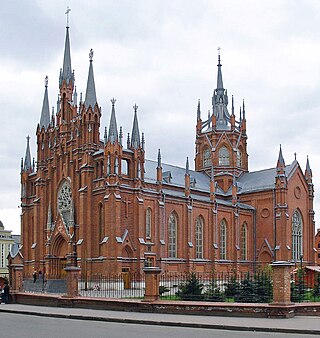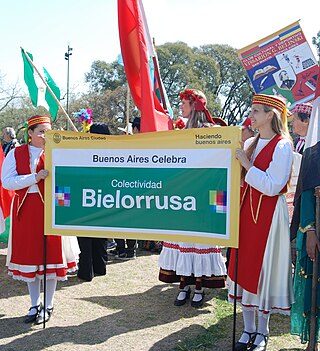
Belarus, officially the Republic of Belarus, is a landlocked country in Eastern Europe. It is bordered by Russia to the east and northeast, Ukraine to the south, Poland to the west, and Lithuania and Latvia to the northwest. Covering an area of 207,600 square kilometres (80,200 sq mi) and with a population of 9.2 million, Belarus is the 13th-largest and the 20th-most populous country in Europe. The country has a hemiboreal climate and is administratively divided into six regions. Minsk is the capital and largest city; it is administered separately as a city with special status.

Belarusians are an East Slavic ethnic group native to Belarus. More than 9 million people proclaim Belarusian ethnicity worldwide. Nearly 7.99 million Belarusians reside in Belarus, with the United States and Russia being home to more than half a million Belarusians each.
The lands of Belarus during the Middle Ages became part of Kievan Rus' and were split between different principalities, including Polotsk, Turov, Vitebsk, and others. Following the Mongol invasions of the 13th century, these lands were absorbed by the Grand Duchy of Lithuania, which later was merged into the Polish–Lithuanian Commonwealth in the 16th century.

The Byelorussian Soviet Socialist Republic, also known as Byelorussia, Belarusian SSR, Soviet Belarus, or simply Belarus, was a republic of the Soviet Union (USSR). It existed between 1920 and 1991 as one of fifteen constituent republics of the USSR, with its own legislation from 1990 to 1991. The republic was ruled by the Communist Party of Byelorussia and was also referred to as Soviet Byelorussia or Soviet Belarus by a number of historians. Other names for Byelorussia included White Russia or White Russian Soviet Socialist Republic and Belorussian Soviet Socialist Republic.

Lithuanians are a Baltic ethnic group. They are native to Lithuania, where they number around 2,378,118 people. Another two millions make up the Lithuanian diaspora, largely found in countries such as the United States, United Kingdom, Brazil, Russia, and Canada. Their native language is Lithuanian, one of only two surviving members of the Baltic language family along with Latvian. According to the census conducted in 2021, 84.6% of the population of Lithuania identified themselves as Lithuanians, 6.5% as Poles, 5.0% as Russians, 1.0% as Belarusians, and 1.1% as members of other ethnic groups. Most Lithuanians belong to the Catholic Church, while the Lietuvininkai who lived in the northern part of East Prussia prior to World War II, were mostly Lutherans.

The Polish diaspora comprises Poles and people of Polish heritage or origin who live outside Poland. The Polish diaspora is also known in modern Polish as Polonia, the name for Poland in Latin and many Romance languages.

The Ukrainian diaspora comprises Ukrainians and their descendants who live outside Ukraine around the world, especially those who maintain some kind of connection to the land of their ancestors and maintain their feeling of Ukrainian national identity within their own local community. The Ukrainian diaspora is found throughout numerous regions worldwide including other post-Soviet states as well as in Canada and other countries such as Poland, the United States, the UK and Brazil.

Belarusian culture is the product of a millennium of development under the impact of a number of diverse factors. These include the physical environment; the ethnographic background of Belarusians ; the paganism of the early settlers and their hosts; Eastern Orthodox Christianity as a link to the Byzantine literary and cultural traditions; the country's lack of natural borders; the flow of rivers toward both the Black Sea and the Baltic Sea; and the variety of religions in the region.

The history of the Jews in Belarus begins as early as the 8th century. Jews lived in all parts of the lands of modern Belarus. In 1897, the Jewish population of Belarus reached 910,900, or 14.2% of the total population. Following the Polish-Soviet War (1919-1920), under the terms of the Treaty of Riga, Belarus was split into Eastern Belorussia and Western Belorussia, and causing 350,000-450,000 of the Jews to be governed by Poland. Prior to World War II, Jews were the third largest ethnic group in Belarus and comprised more than 40% of the urban population. The population of cities such as Minsk, Pinsk, Mahiliou, Babrujsk, Viciebsk, and Homiel was more than 50% Jewish. In 1926 and 1939 there were between 375,000 and 407,000 Jews in Belarus or 6.7-8.2% of the total population. Following the Soviet annexation of Eastern Poland in 1939, including Western Belorussia, Belarus would again have 1,175,000 Jews within its borders, including 275,000 Jews from Poland, Ukraine, and elsewhere. It is estimated 800,000 of 900,000 — 90% of the Jews of Belarus —were killed during the Holocaust. According to the 2019 Belarusian census, there were 13,705 self-identifying Jews in Belarus, of which most are of Ashkenazi origin. However, the Israeli embassy in Belarus claims to know about 30-50 thousand Belarusians with Jewish descent.

The Russian diaspora is the global community of ethnic Russians. The Russian-speaking (Russophone) diaspora are the people for whom Russian language is the native language, regardless of whether they are ethnic Russians or not.

Belarusians are a major ethnic group in Russia. At the census of 2010, 521,443 Russian citizens indicated Belarusian ancestry. Major Belarusian groups live in the regions of Moscow, St. Petersburg, Kaliningrad, Karelia and Siberia. Most Belarusians in Russia are migrants from modern Belarus or their descendants, while a minor part of Belarusians in Russia are indigenous.

Belarusian Americans or White Russian Americans are Americans who are of total or partial Belarusian ancestry.

The Polish population transfers in 1944–1946 from the eastern half of prewar Poland, were the forced migrations of Poles toward the end and in the aftermath of World War II. These were the result of a Soviet Union policy that had been ratified by the main Allies of World War II. Similarly, the Soviet Union had enforced policies between 1939 and 1941 which targeted and expelled ethnic Poles residing in the Soviet zone of occupation following the Nazi-Soviet invasion of Poland. The second wave of expulsions resulted from the retaking of Poland from the Wehrmacht by the Red Army. The USSR took over territory for its western republics.

Belarusian literature is the writing produced, both prose and poetry, by speakers of the Belarusian language.

The Latvian diaspora refers to Latvians and people of Latvian descent residing outside Latvia.
Belarusian Australians refers to Australians of full or partial Belarusian national background or descent, or Belarusian citizens living in Australia.

Belarusian Argentines are a part of the Belarusian diaspora that consists of the Belarusians who emigrated to Argentina and their descendants. The community was formed in the 20th century, now it accounts for 7,000 people and about 50,000 descendants.
Refugees in Poland were, until 2022, a relatively small group. Since 1989, the number of people applying for refugee status in Poland has risen from about 1,000 to 10,000 each year; about 1–2% of the applications were approved. The majority of applications were citizens of the former Soviet Union.

New York City includes a sizeable Belarusian American population. The New York metropolitan area has one of the largest concentrations of Belarusians in the United States. Many Belarusians live in Brighton Beach and elsewhere in South Brooklyn, along with other ex-Soviet immigrants including Russians and Ukrainians. Around 55,000 people of Belarusian descent live in the New York City metropolitan area, with estimates ranging from 50,000 to 75,000.
























